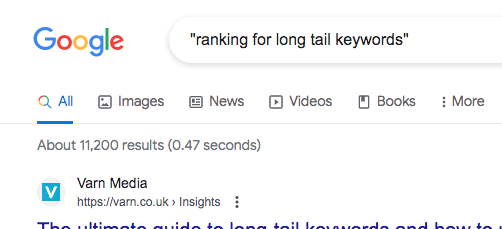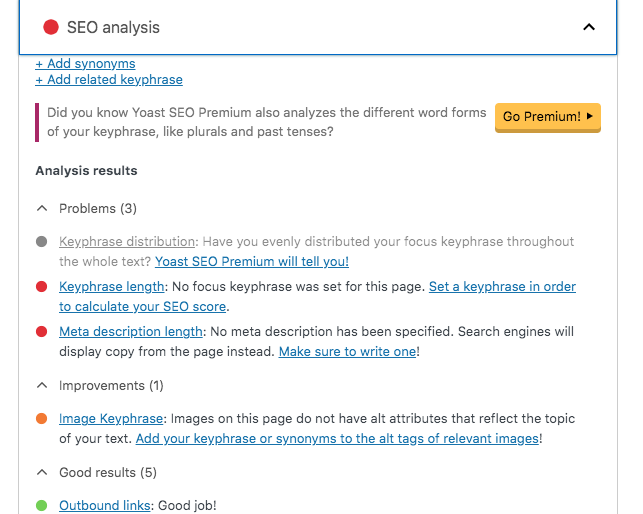Ranking for long tail keywords is a simple strategy used by many bloggers. Long tail keywords have far less competition on the SERPS – Search Engine Results Pages. So you’ve a much better chance of getting your content to rank on the top of the first page of Google. That’s where all the search traffic is! Even getting your content on the first page of Google is a challenge. But it’s much more of a challenge if you create content around competitive keywords.
That’s why bloggers find long tail keywords with low SEO difficulty. If you’re successful it means free traffic. But it’s not guaranteed that you’ll get a top place listing. To give yourself the best possible chance, use a keyword planner and choose those keywords which have the least competition on Google.
A simple method to see the competition for a possible keyword is to do a search on Google for it on a desktop computer or laptop. You should see a number at the top of your search results. This denotes the number of competing webpages brought up for that particular term. A phrase search gives you the pages which specifically relate to that term as a whole.

Ranking For Long Tail Keywords – Creating Content
The top result for your search is the best quality web page which Google thinks should rank at the very top! So all you need to do next is to create an awesome piece of content using your keyword as your blog post title.
Out perform the top existing result and create content which is longer and better than the existing top ranking. To help you do this optimally, you can use an SEO plugin which assists you with your keyword placement, links and tags. I use Yoast SEO but there’s a few other plugins which can help you with this.

Yoast will give your content a score for each SEO point which helps with your ranking. SEO (search engine optimisation) analysis includes things such as your keyword length, titles, image alt tags and links. It’s also a good idea to write a lengthy piece of content which is longer than the existing top ranking. Providing of course that your content is of high quality too!

Ranking For Long Tail Keywords – Finding The Diamonds In The Rough
Before you can write content for your keyword, you need to do some keyword research. I use Google’s keyword planner but there’s also ubersuggest. Type in your main “seed” keyword and the tools will give you a number of long tail derivatives of it. Here’s a few of the keywords which came up when I used the term long tail keyword in Ubersuggest:

Here’s a few examples from Google’s planner:

You should see the most searched for terms appear at the top of your search. To find the longer tail keywords you can scroll to the bottom of the list. As you can see in the image above, the keywords show a low monthly search volume of between 20 and 30 searches.
Although this might mean you’ll get fewer visits if you rank for those terms, a little of something is better than nothing of a lot! When you compare the competitiveness of the high search volume terms, you’ll find those terms are almost impossible to rank for.
The search term I used for this article “ranking for long tail keywords” only gets 20 monthly visits according to Google’s keyword planner.

So even if I managed to rank this article at the top of Google, I’ll still only get a share of those 20! (Some people will click on the 2nd ranking website, or the third or 4th). But by using this tactic for multiple long tail keywords, you can build many sources of traffic from multiple articles which you create. Of course there’s also Bing, Duckduckgo.com and other search engines too other than Google which account for some traffic.
How Long Does It Take?
Keep in mind that your content may not rank on Google even after you put all that work in! Once you’ve created it it’s kind of up to Google whether to rank you or not. But other search engines can also rank you too, so all is not lost! Ideally make sure your content is useful and of high quality. If it is, it’s much more likely to stand the test of time and give you some free traffic.
Ranking content on Google can take some time too. It can take days, weeks or months before your content appears depending on your site and other competition. Google uses a ranking algorithm to determine how to perceive your content:
- Domain age – older domains will typically outperform newer ones
- Backlink profile – how many backlinks to your site and where are they from
- Content quality – how much content and how it is perceived
- How visitors perceive your content – click away rate
- Social media presence – is your content readily shared and interacted with?
So to give yourself the best chance of a ranking it’s also worth promoting your content as much as possible too. Don’t rely solely on Google ranking you. You can also use that content to get traffic through sharing it as much as possible. Use social media share buttons, automate share plugins and syndicate your content to as many social media platforms as you can. See also best free blog plugins for WordPress.
Summary
Once you’ve created an awesome piece of content don’t rest on your laurels and sit back waiting for traffic! It may never come! Move on to another piece and then another.

Many pieces of content will add up and eventually you’ll have a nice steady stream of free traffic when you’ve built a lot of useful content. Make sure you promote your content too. Use an email list and send your subscribers to it. Use Push Engage to reengage visitors and bring them back to your site when they opt in. You can automate older post syndication with this free tool.
Work on building multiple sources of traffic and don’t rely on just one! Some of your content will rank and some probably won’t. I’ll check back in a few weeks and see whether this one did!